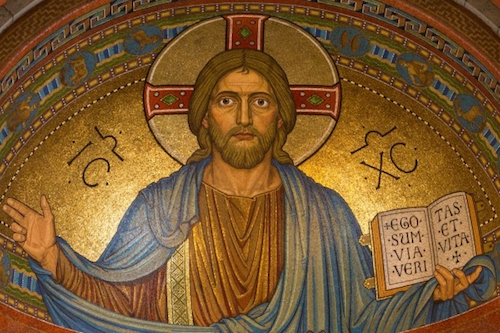We run our website the way we wished the whole internet worked: we provide high quality original content with no ads. We are funded solely by your direct support. Please consider supporting this project.

Jesus is the Center of the Story
The previous post addressed how the revelation of Christ is the surprising twist that reframes how we must read all that precedes it. Today we’ll look briefly at five supports to this claim.
- Jesus said, “I have a testimony greater than that of John” (John 5:36). Jesus elsewhere claims that “among those born of women there has not risen anyone greater than John the Baptist” (Matt 11:11). Jesus places the words and ministry of John above any of the OT prophets, and yet he tells us that his own testimony is “weightier” than John’s!
- The writer of Hebrews stated that while God spoke in a variety of ways in the past, Jesus supersedes all these past revelations (Heb 1:1-3). Unlike past revelations that were mediated through prophets, Jesus is God’s own Son. The author is essentially saying that the revelation of God in his Son contrasts with the “various ways” God was revealed in the past, because in the Son we finally have God in person.
- Jesus said, “No one knows the Father except the Son and those whom the Son chooses to reveal him” (Matt 11:27). Jesus is actually saying that no one knows God except him! Now, ancient Jewish culture made use of hyperbole (exaggerated language). In this light, combined with the fact that Jesus himself quotes the Old Testament as the Word of God, I don’t believe we should take Jesus’s statement too literally and conclude that Jesus didn’t believe Old Testament authors knew anything about God. But, at the very least, this hyperbolic statement indicates that Jesus sees his knowledge of the Father as dwarfing in significance all who came before him.
- While Jesus is praying on the Mount of Transfiguration, Peter, James, and John behold Jesus’s “glory” and then witness Moses and Elijah talking to him. They hear a voice from heaven saying, “This is my Son, whom I have chosen; listen to him” (Luke 9:33). The voice tells the disciples to listen to Jesus, suggesting that they are to submit to Jesus’s teachings and revelation alone. And the superiority of Christ is reflected in the fact that the radiance of Jesus outshines that of Moses and Elijah.
- Jesus felt free to at times replace teachings of the Old Testament with his own. For instance, while the OT commands people to make oaths in God’s name (Deut 6:13), Jesus forbids it (Matt 5:33-37). And while the OT commands an “eye for eye and tooth for tooth,” Jesus commands people to “not resist an evil person,” adding that “if anyone slaps you on the right cheek, turn to them the other cheek also” (Matt 5:28-29).
In a first-century Jewish setting, it’s hard to image anything that would be more shocking than for someone to place his own teaching above Scripture. But this is exactly what Jesus and the NT writers claimed. We cannot ignore the fact that these five points demonstrate that Jesus’s own teaching and his own revelation of God are above that of the Old Testament. Jesus truly is the twist that reframes everything.
—Adapted from Benefit of the Doubt, pages 177-183
Photo via Visual hunt
Category: General
Tags: Bible, Bible Interpretation, Cruciform Theology, Jesus
Topics: Biblical Interpretation
Related Reading

Getting Honest about the Dark Side of the Bible
Eddy Van 3000 via Compfight While most of the Bible exhibits a “God-breathed” quality, reflecting a magnificently beautiful God that is consistent with God’s definitive revelation on the cross, we must honestly acknowledge that some depictions of God in Scripture are simply horrific. They are included in what is sometimes called “the dark side of…

Podcast: How Does God’s Wrath Fit within a Cruciform Theology?
Greg considers God’s wrath. http://traffic.libsyn.com/askgregboyd/Episode_0390.mp3

Spiritual Warfare: What is it?
The Kingdom is “not of this world,” and neither is its warfare. Jews had always believed that God confronted spiritual opposition in carrying out his will on earth. In the Old Testament, these evil forces were usually depicted as cosmic monsters and hostile waters that threatened the earth. For a variety of reasons this belief…

Jesus: True Myth and True History
Though the Jesus story gives us every reason to believe it is substantially rooted in history, it has a curious, and fascinating, relationship with myth and legend. The story of God coming to earth, being born of a virgin, manifesting a heroic, counter-cultural love toward outcasts, dying for the people who crucified him and then…

Parable of the Jerk Loser Son
Birmingham Museum and Art Gallery via Compfight Peter Enns blogged about the parable of the prodigal son, or as he likes to call it, “the parable of the jerk loser son.” It’s actually a reflection about the unbelievable and scandalous love of God. I guarantee it will bless you. From the article: The story isn’t about…

